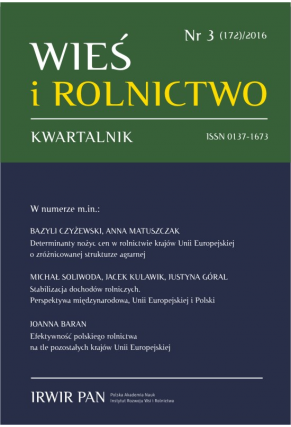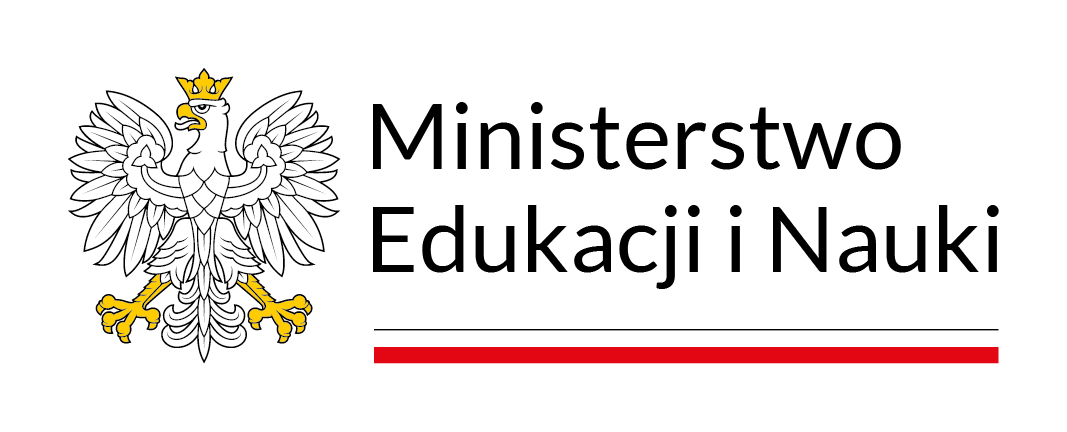Renewable Energy – Implications for Agriculture and Rural Development in Poland
DOI:
https://doi.org/10.53098/wir032017/06Keywords:
renewable energy, rural development, biofuelsAbstract
Due to their quantitative and qualitative potential, rural areas participate to a significant degree in the achievement of the indicative targets resulting from the climatic package. Thanks to the production of biomass and, increasingly often, energy itself during the 2005–2014 period, the share of RES (renewable energy sources) in the production of primary energy grew twofold from 5.8% to 12.1%. Biomass was the main source, but since 2010 the use of wind and sun in the production of energy has been growing rapidly. Given that the costs of alternative sources for energy production (mainly electricity) are considerably higher than in case of using raw fuels, the development of this market depends on the amount of subsidies. The system applied in Poland is widely criticized because it favours large hydroelectric power plants and co-combustion, which arouses considerable environmental, technical, market and strategic controversies. Maintaining the current support system could therefore have significant implications for the structure of the market, because it is not conducive to the development of energy, based on the initiative of citizens and their communities. It remains untapped economic potential also in industrial policy and services and, in particular, in case of RES small- and micro-installations.References
Ancygier A., Szulecki K. (2013). Local energy – a renewable? Research Report acceptance of renewable energy sources and prospects for their development in the Polish municipalities ESPRI Report No.1 – December.
Bańkowska K. (2015). Climate and energy package as a determinant of rural transformation. Annals of the Polish Association of Agricultural and Agribusiness Economists, 17 (4), pp. 16–20.
Borychowski M. (2016). Economic determinants for development of liquid biofuels sector in Poland and Germany after 2004. Uniwersytet Ekonomiczny w Poznaniu.
Build up Skills, Energy Training for Builders: Strategies for building skills in the field of renewable energy technologies and activities to increase energy efficiency in buildings (2013). Warszawa, April.
Bukowski M., Karaczun Z. (2015). In the interest of Poland – How to use energy and climate policy of the EU to support the development of Poland 2030, Niskoemisyjna Polska 2050, p. 27.
Communication from the Commission COM/97/0599 final of 26 November 1997 – Energy for the future: renewable sources of energy – White Paper for a Community strategy and action plan.
Communication from the Commission to the European Parliament, the Council, the European Economic and Social Committee and the Committee of the Regions a Roadmap for moving to a competitive low carbon economy in 2050 Brussels, 08.03.2011, COM (2011) 112 final.
(COM(2012)0595 – C7-0337/2012 – 2012/0288(COD)) P7_TC1-COD(2012)0288 Position of the European Parliament adopted at first reading on 11 September 2013 with a view to the adoption of Directive 2013/…/EU of the European Parliament and of the Council amending Directive 98/70/EC relating to the quality of petrol and diesel fuels and amending Directive 2009/28/EC on the promotion of the use of energy from renewable sources Text with EEA relevance.
Conference of the Parties Twenty-first session Paris, 30 November to 11 December 2015, ADOPTION OF THE PARIS AGREEMENT. http://ziemianarozdrozu.pl/dl/Final-COP21-draft.pdf [accessed 13.07.2016].
Directions of agricultural biogas plants development in Poland 2010–2020 (2010). Urząd Rady Ministrów, Warszawa.
Directive 2001/77/EC of the European Parliament and of the Council of 27 September 2001 on the promotion of electricity produced from renewable energy sources in the internal electricity market.
Directive 2009/28/EC of the European Parliament and of the Council of 23 April 2009 on the promotion of the use of energy from renewable sources and amending and subsequently repealing Directives 2001/77/EC and 2003/30/EC.
Dziamski P. (2015). Jakość energii w gospodarstwach rolnych. Instytut Energetyki Odnawialnej. http://www.gospodarzzenergia.pl/raporty,jakosc-energii-w-gospodarstwach-rolnych,v10 [accessed 11.03.2016].
Energy Law Act of 10 April 1997 r. (Dz.U. z 1997 r. nr 54, poz. 348).
Energy Policy of Poland until 2030 (2009). Ministerstwo Gospodarki, Warszawa.
Gradziuk P. (red.) (2003). Biofuels. Warszawa: Wieś Jutra.
Gradziuk P. (2015). Gospodarcze znaczenie i możliwości wykorzystania słomy na cele energetyczne w Polsce. Puławy: Wydawnictwo Instytutu Uprawy, Nawożenia i Gleboznawstwa – Państwowy Instytut Badawczy w Puławach.
Gzyra Z. (2014). Threats to the biofuels market. The activities of the Coalition for Biofuels, X Forum of Rapeseed and Protein Plant Producers “Rape and protein crops – production, marketing system and use”, Międzynarodowe Targi Poznańskie, 31 styczeń, Poznań.
Instytut Energetyki Odnawialnej (2007). The possibilities of using renewable energy sources in Poland until 2020, the report drawn up by the Ministry of Economy. Warszawa.
Instytut Energetyki Odnawialnej (2013). Poles about renewable energy sources. Warszawa.
Instytut Energetyki Odnawialnej (2015). National plan of development of micro-installations in Renewable Energy till 2020. Warszawa.
Key Word Energy Statistic 2006–2014. International Energy Agency; BP Statistical Review of Word Energy, June.
Krugman P. (2008). Grains gone wild, op-ed columnist. New York Times, 7.04.2008. http://www.nytimes.com/2008/04/07/opinion/07krugman.html [accessed: 12.07.2016].
Matyka M. (2011). Rolnictwo a odnawialne źródła energii – szanse i zagrożenia. In: J.S. Zegar (ed.). Z badań nad rolnictwem społecznie zrównoważonym (11). Program Wieloletni 2011–2014, nr 3. Warszawa: Instytut Ekonomiki Rolnictwa i Gospodarki Żywnościowej – Państwowy Instytut Badawczy.
National Action Plan for energy from renewable sources (2010). Ministerstwo Gospodarki, Warszawa.
National Action Plan on energy efficiency for Poland (2014). Ministerstwo Gospodarki, Warszawa.
National Programme for the Development of Low Carbon Economy (Project: version 4 August 2015). Ministerstwo Gospodarki, Warszawa.
Opinion of the European Economic and Social Committee on the ‘Proposal for a Directive of the European Parliament and of the Council amending Directive 98/70/EC concerning the quality of petrol and diesel fuels and amending Directive 2009/28/EC concerning the promotion of the use of energy from renewable sources’ COM(2012) 595 final – 2012/0288 (COD) (2013/C 198/09).
Prandecki K., Floriańczyk Z. (2014). Z badań nad rolnictwem społecznie zrównoważonym (28). Produktywność różnych form rolnictwa zrównoważonego, Program Wieloletni 2011–2014, nr 137. Warszawa: Instytut Ekonomiki Rolnictwa i Gospodarki Żywnościowej – Państwowy Instytut Badawczy.
Rosiak E., Łopaciuk W., Krzemiński M. (2011). Produkcja biopaliw i jej wpływ na światowy rynek zbóż oraz roślin oleistych i tłuszczów roślinnych. Program Wieloletni 2011–2014, nr 29. Warszawa: Instytut Ekonomiki Rolnictwa i Gospodarki Żywnościowej – Państwowy Instytut Badawczy.
Regulation of the Minister of Economy of 2 February 1999. On the obligation to purchase electricity and heat from unconventional sources and the extent of this obligation (Dz.U. z 1999 r. nr 13, poz. 119).
Sidorczuk-Pietraszko E. (2015). Wpływ instalacji odnawialnych źródeł energii na tworzenie miejsc pracy w wymiarze lokalnym. Ekonomia i Środowisko, 3 (54), 39–40. DOI: https://doi.org/10.15611/pn.2013.317.06
Smil V. (1999). Crop residues: Agriculture’s largest harvest. BioScience, 49, 299–308. DOI: https://doi.org/10.2307/1313613
Sobierajewska J. (2009). Economic aspects of the use of bioester 100 in Polish agriculture. In: B. Klepacki (ed.). Ekonomiczne uwarunkowania stosowania odnawialnych źródeł energii (pp. 37–38). Warszawa: Szkoła Główna Gospodarstwa Wiejskiego.
Strategy for Energy Security and Environment prospect till 2020, Annex to the resolution of the Council of Ministers no. 58, 15 April 2014. (poz. 469).
Szajner P. (ed.) (2015). Sytuacja na światowym rynku zbóż, roślin oleistych, cukru i biopaliw oraz jej wpływ na krajowe rynki produktów roślinnych i możliwości ich rozwoju. Program Wieloletni 2015–2019, nr 1. Warszawa: Instytut Ekonomiki Rolnictwa i Gospodarki Żywnościowej – Państwowy Instytut Badawczy.
TNS, The study of ecological awareness and behavior of Polish citizens, November 2014.
TNS Analysis Report of research on awareness, attitudes and ecological behavior, July 2015.
Wiśniewski G. (2015). Dylematy strategiczne sektora odnawialnych źródeł energii. Energetyka – Społeczeństwo – Polityka, 1, 37–64.
Working for the climate. Green jobs in Poland (2011). Greenpeace Polska.
Zegar J.S. (2012a). Uwarunkowania i czynniki rozwoju rolnictwa zrównoważonego we współczesnym świecie. In: J.S. Zegar (ed.). Z badań nad rolnictwem społecznie zrównoważonym (15). Program Wieloletni 2011–2014, nr 50. Warszawa: Instytut Ekonomiki Rolnictwa i Gospodarki Żywnościowej – Państwowy Instytut Badawczy.
Zegar J.S. (2012b). Współczesne wyzwania rolnictwa. Warszawa: Wydawnictwo Naukowe PWN.
Zegar J.S. (2014). Z badań nad rolnictwem społecznie zrównoważonym (30). Konkurencyjność rolnictwa zrównoważonego (Synteza). Program Wieloletni 2011–2014, nr 142. Warszawa: Instytut Ekonomiki Rolnictwa i Gospodarki Żywnościowej – Państwowy Instytut Badawczy.
Żylicz T. (2012). Ekonomia wobec wspierania odnawialnych źródeł energii. In: Generacja rozproszona w nowoczesnej polityce energetycznej – wybrane problemy i wyzwania. (pp. 46–50). Warszawa: Narodowy Fundusz Ochrony Środowiska i Gospodarki Wodnej.
Downloads
Article file downloads
Pages
How to Cite
Issue
Section
License
Copyright (c) 2017 Wieś i Rolnictwo

This work is licensed under a Creative Commons Attribution 4.0 International License.










